Attached files
| file | filename |
|---|---|
| 8-K - 8-K - GATX CORP | gatx-20210908.htm |
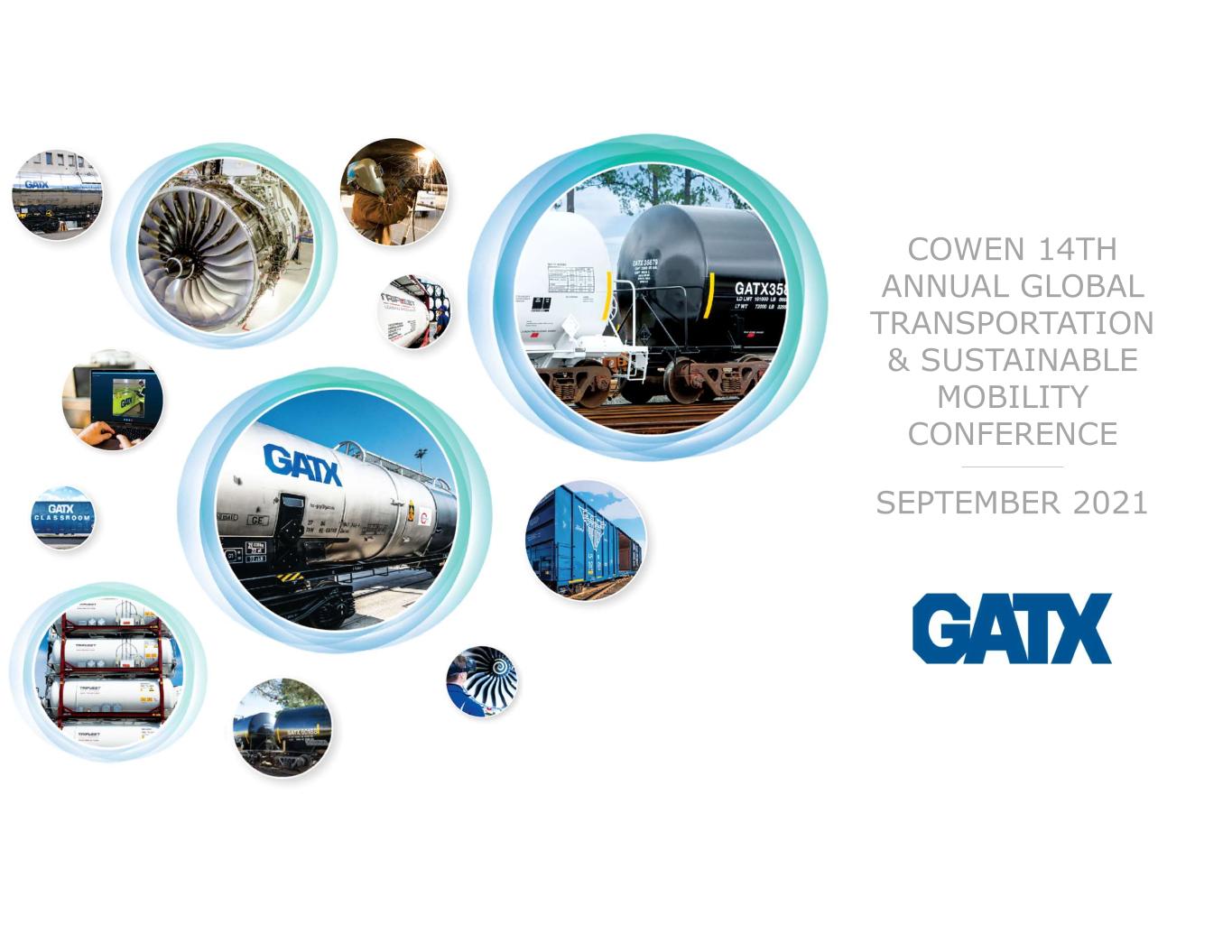
COWEN 14TH ANNUAL GLOBAL TRANSPORTATION & SUSTAINABLE MOBILITY CONFERENCE SEPTEMBER 2021

Statements in this presentation not based on historical facts are “forward-looking statements” within the meaning of the Private Securities Litigation Reform Act of 1995 and, accordingly, involve known and unknown risks and uncertainties that are difficult to predict and could cause our actual results, performance, or achievements to differ materially from those discussed. These include statements as to our future expectations, beliefs, plans, strategies, objectives, events, conditions, financial performance, prospects, or future events. In some cases, forward-looking statements can be identified by the use of words such as “may,” “could,” “expect,” “intend,” “plan,” “seek,” “anticipate,” “believe,” “estimate,” “predict,” “potential,” “outlook,” “continue,” “likely,” “will,” “would,” and similar words and phrases. Forward-looking statements are necessarily based on estimates and assumptions that, while considered reasonable by us and our management, are inherently uncertain. Accordingly, you should not place undue reliance on forward-looking statements, which speak only as of the date they are made, and are not guarantees of future performance. We do not undertake any obligation to publicly update or revise these forward-looking statements. The following factors, in addition to those discussed in our other filings with the U.S. Securities and Exchange Commission (“SEC”), including our Form 10-K for the year ended December 31, 2020 and subsequent reports on Form 10-Q, could cause actual results to differ materially from our current expectations expressed in forward-looking statements: the duration and effects of the global COVID-19 pandemic, including adverse impacts on our business, personnel, operations, commercial activity, supply chain, the demand for our transportation assets, the value of our assets, our liquidity, and macroeconomic conditions exposure to damages, fines, criminal and civil penalties, and reputational harm arising from a negative outcome in litigation, including claims arising from an accident involving our transportation assets inability to maintain our transportation assets on lease at satisfactory rates due to oversupply of assets in the market or other changes in supply and demand a significant decline in customer demand for our transportation assets or services, including as a result of: • weak macroeconomic conditions • weak market conditions in our customers' businesses • adverse changes in the price of, or demand for, commodities • changes in railroad operations, efficiency, pricing and service offerings, including those related to "precision scheduled railroading" • changes in supply chains • availability of pipelines, trucks, and other alternative modes of transportation • changes in conditions affecting the aviation industry, including reduced demand for air travel, geographic exposure and customer concentrations • other operational or commercial needs or decisions of our customers • customers’ desire to buy, rather than lease, our transportation assets higher costs associated with increased assignments of our transportation assets following non-renewal of leases, customer defaults, and compliance maintenance programs or other maintenance initiatives events having an adverse impact on assets, customers, or regions where we have a concentrated investment exposure financial and operational risks associated with long-term purchase commitments for transportation assets reduced opportunities to generate asset remarketing income inability to successfully consummate and manage ongoing acquisition and divestiture activities reliance on Rolls-Royce in connection with our aircraft spare engine leasing businesses, and the risks that certain factors that adversely affect Rolls-Royce could have an adverse effect on those businesses fluctuations in foreign exchange rates failure to successfully negotiate collective bargaining agreements with the unions representing a substantial portion of our employees asset impairment charges we may be required to recognize deterioration of conditions in the capital markets, reductions in our credit ratings, or increases in our financing costs changes in banks' inter-lending rate reporting practices and the phasing out of LIBOR competitive factors in our primary markets, including competitors with significantly lower costs of capital risks related to our international operations and expansion into new geographic markets, including laws, regulations, tariffs, taxes, treaties or trade barriers affecting our activities in the countries where we do business changes in, or failure to comply with, laws, rules and regulations inability to obtain cost-effective insurance environmental liabilities and remediation costs potential obsolescence of our assets inadequate allowances to cover credit losses in our portfolio operational, functional and regulatory risks associated with severe weather events, climate change and natural disasters inability to maintain and secure our information technology infrastructure from cybersecurity threats and related disruption of our business 2 Forward-Looking Statements

GATX Today – Business Segments 66% 21% 8% 5% PORTFOLIO MANAGEMENT Largely comprised of our 50% ownership of Rolls-Royce and Partners Finance Affiliates (RRPF), a leading worldwide lessor of aircraft spare engines RRPF has 445 aircraft spare engines with $4.8 billion of net book value In January 2021, GATX commenced a program of direct investment in aircraft spare engines RAIL NORTH AMERICA Premier railcar lessor Diversified fleet of over 118,000 railcars Strong customer credit quality, diversification in car types and commodities carried $2.4 billion of contractual lease receipts as of 12/31/2020 RAIL INTERNATIONAL GATX Rail Europe (GRE) is a leading European tank car and freight car lessor with over 26,000 railcars Strong customer credit quality, diversification in car types, geography, and commodities carried GATX Rail India (GRI) is the largest private railcar lessor in India with over 4,000 railcars ~$8.9 Billion NBV Rail North America Rail International Portfolio Management Other NET BOOK VALUE OF ASSETS 3 As of 12/31/2020

28% 24% 19% 14% 6% 9% GATX Rail North America Overview *Excludes boxcar fleet Chemicals Refiners & Other Petroleum Railroads & Other Transports Food & Agriculture Mining, Minerals & Aggregates Other Based on 2020 Rail North America Revenue 50% 60% 70% 80% 90% 100% 2002 2004 2006 2008 2010 2012 2014 2016 2018 2020 90% 98%96% 99% WHOLLY OWNED FLEET COUNT 118,000+ CAR TYPE COUNT 160+ AVERAGE FLEET AGE 20 Years LOCOMOTIVE COUNT 625+ NUMBER OF CUSTOMERS 850+ COUNTRIES OF OPERATIONS U.S., Canada, & Mexico 2020 OVERVIEW FLEET UTILIZATION* INDUSTRIES SERVED 4

5 BUY the railcar at an economically attractive and competitively advantaged price at the right time LEASE the railcar to a quality customer at an attractive rate for a term that reflects the business cycle SERVICE the railcar in a manner that maximizes safety, in-use time, and customer satisfaction MAXIMIZE the value of the railcar by selling or scrapping at the optimal time Straightforward and Proven Business Model

6 0 500 1,000 1,500 2,000 2,500 1 Q 0 8 2 Q 0 8 3 Q 0 8 4 Q 0 8 1 Q 0 9 2 Q 0 9 3 Q 0 9 4 Q 0 9 1 Q 1 0 2 Q 1 0 3 Q 1 0 4 Q 1 0 1 Q 1 1 2 Q 1 1 3 Q 1 1 4 Q 1 1 1 Q 1 2 2 Q 1 2 3 Q 1 2 4 Q 1 2 1 Q 1 3 2 Q 1 3 3 Q 1 3 4 Q 1 3 1 Q 1 4 2 Q 1 4 3 Q 1 4 4 Q 1 4 1 Q 1 5 2 Q 1 5 3 Q 1 5 4 Q 1 5 1 Q 1 6 2 Q 1 6 3 Q 1 6 4 Q 1 6 1 Q 1 7 2 Q 1 7 3 Q 1 7 4 Q 1 7 1 Q 1 8 2 Q 1 8 3 Q 1 8 4 Q 1 8 1 Q 1 9 2 Q 1 9 3 Q 1 9 4 Q 1 9 1 Q 2 0 2 Q 2 0 3 Q 2 0 4 Q 2 0 1 Q 2 1 2 Q 2 1 All Other Coal & Coke Sand, Stone, Minerals, & Related Products Grain Petroleum Products T H O U S A N D S QUARTERLY COMMODITY CARLOAD TRAFFIC 6 Association of American Railroads Industry Commodity Carloadings: North America

Number of Tank Number of Freight Cyclicality of the industry is illustrated by the backlog of orders at the railcar manufacturers The 2013 and 2014 spike in tank car backlog was primarily due to the crude boom Backlogs have moderated post-crude boom, with the recent decline attributable to Precision Scheduled Railroading (PSR), freight market weakness, and, in 2020, the economic impacts of COVID-19 - 20,000 40,000 60,000 80,000 100,000 120,000 140,000 160,000 ’99 ’00 ’01 ’02 ’03 ’04 ’05 ’06 ’07 ’08 ’09 ’10 ’11 ’12 ’13 ’14 ’15 ’16 ’17 ’18 ’19 ’20 ‘21 INDUSTRY BACKLOGS 7 Railway Supply Institute as of July 2021 Industry Backlog: North America
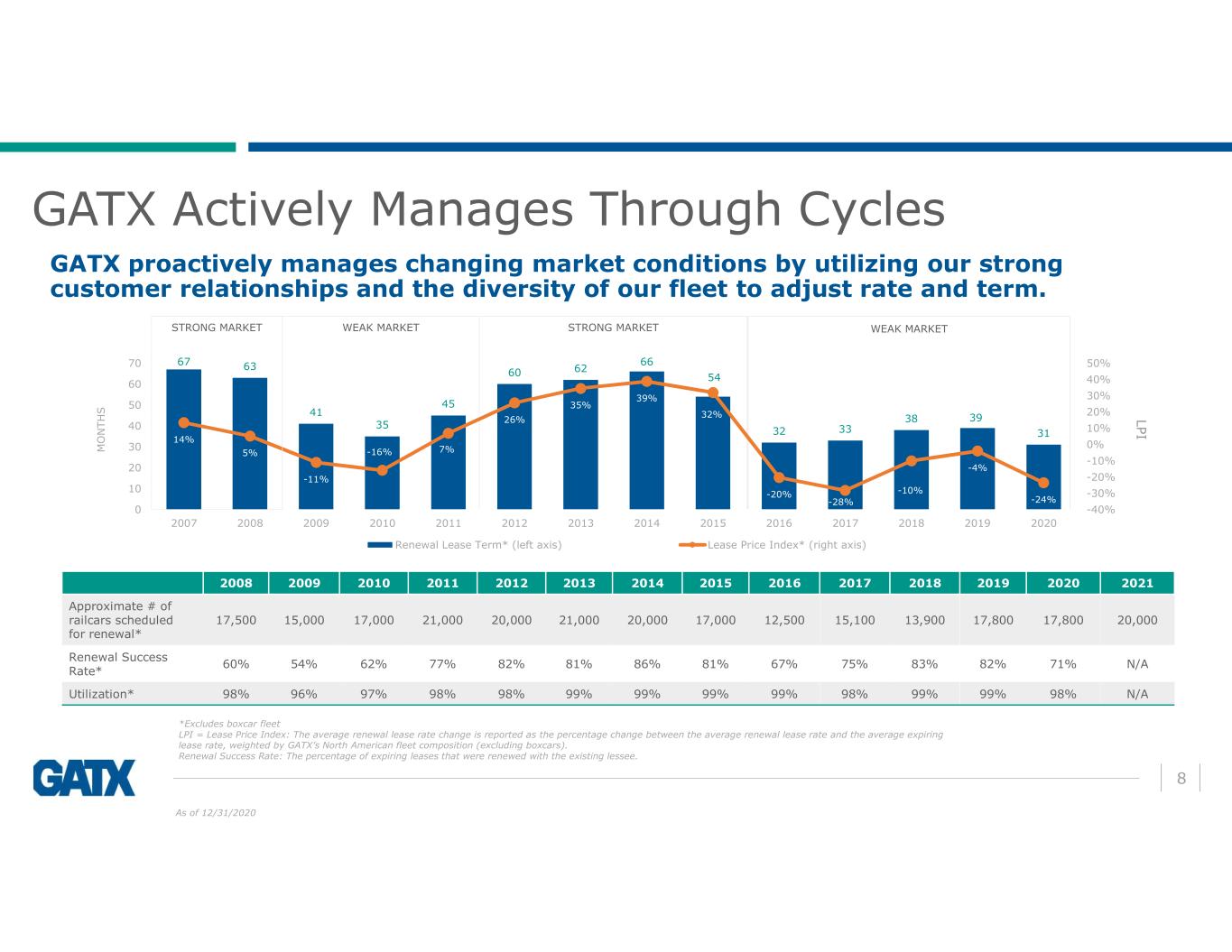
STRONG MARKETWEAK MARKET WEAK MARKET 67 63 41 35 45 60 62 66 54 32 33 38 39 31 14% 5% -11% -16% 7% 26% 35% 39% 32% -20% -28% -10% -4% -24% -40% -30% -20% -10% 0% 10% 20% 30% 40% 50% 0 10 20 30 40 50 60 70 2007 2008 2009 2010 2011 2012 2013 2014 2015 2016 2017 2018 2019 2020 Renewal Lease Term* (left axis) Lease Price Index* (right axis) 2008 2009 2010 2011 2012 2013 2014 2015 2016 2017 2018 2019 2020 2021 Approximate # of railcars scheduled for renewal* 17,500 15,000 17,000 21,000 20,000 21,000 20,000 17,000 12,500 15,100 13,900 17,800 17,800 20,000 Renewal Success Rate* 60% 54% 62% 77% 82% 81% 86% 81% 67% 75% 83% 82% 71% N/A Utilization* 98% 96% 97% 98% 98% 99% 99% 99% 99% 98% 99% 99% 98% N/A M O N T H S *Excludes boxcar fleet LPI = Lease Price Index: The average renewal lease rate change is reported as the percentage change between the average renewal lease rate and the average expiring lease rate, weighted by GATX’s North American fleet composition (excluding boxcars). Renewal Success Rate: The percentage of expiring leases that were renewed with the existing lessee. LP I GATX proactively manages changing market conditions by utilizing our strong customer relationships and the diversity of our fleet to adjust rate and term. 8 GATX Actively Manages Through Cycles As of 12/31/2020 STRONG MARKET

GATX Strategy in Today’s Environment 9 Operate the Business Safely and Efficiently • Maintain a safe and healthy work environment • Continue to maintain fleet to meet customer needs − All owned facilities are fully operating • Remain focused on efficiency improvements in owned maintenance network Practice a Disciplined Capital Allocation Strategy • Place new cars from long- term supply agreements • Pursue attractive incremental investments − Over 1,000 railcars outside of supply agreements to be delivered by mid-2022 Outperform the Competition • Maintain focus on utilization; highest reported utilization in North America • Execute cyclically aware management of lease terms and assets by car-type • Leverage the strength of our full service offering, diversity of our fleet, and depth of customer relationships

95% 97% 96% 99% 98% 50% 60% 70% 80% 90% 100% 2008 2010 2012 2014 2016 2018 2020 GATX Rail International Overview FLEET COUNT 26,300+ in Europe (GRE) 4,500+ in India and Russia CAR TYPE COUNT 50+ AVERAGE FLEET AGE (GRE) 17 Years NUMBER OF CUSTOMERS 250+ COUNTRIES OF OPERATIONS Poland, Germany, Austria, India, Switzerland, The Netherlands, Hungary, Czech Republic, and France 2020 OVERVIEW 10 FLEET UTILIZATION Mineral Oil Liquefied Petroleum Gas Chemicals Freight & Intermodal 44% 15% 12% 29% INDUSTRIES SERVED Based on 2020 Rail International Fleet Count

$0 $2 $4 $6 $8 $10 $12 $14 $16 $18 $20 $0 $20 $40 $60 $80 $100 $120 $140 $160 NBV (left axis) Lease Income (right axis) $ M IL LI O N S $ M ILLIO N S GATX’s GROWTH IN INDIA GATX obtained the first-ever wagon leasing license in 2012 and is the largest private railcar lessor in India. KEY ATTRIBUTES Local Technical and Operational Capabilities Leverages GATX’s fleet management expertise to generate competitive advantages and premium customer services Wholly Owned Fleet of over 4,100 railcars Serving customers in the automotive, container, steel, cement, and bulk commodities transport sector Strong Utilization and Long Lease Term High fleet utilization (99%-100%) with average remaining lease term of 6 years High Growth Opportunity Actively seeks attractive investment opportunities to grow and diversify the fleet 11 GATX Rail India Overview As of 12/31/2020

83% 16% 1% $706.1M NBV Spare Engine Count: 445 Average Fleet Age: 12 Years 2020 RRPF OVERVIEW Aircraft Spare Engine Leasing Affiliates (RRPF) Marine Equipment Other $0 $20 $40 $60 $80 $100 2002 2004 2006 2008 2010 2012 2014 2016 2018 2020 RRPF JV PRE-TAX INCOME (GATX’s SHARE) $ M IL LI O N S ASSET MIX 36% 17% 17% 9% 8% 4% 9% Based on NBV of approximately $4.8B; 100% of RRPF’s portfolio Trent XWB (A350) Trent 700 / 7000 (A330) Trent 1000 (B787) Trent 900 (A380) V2500 (A320) Trent 800 (B777) Other RRPF ENGINE TYPES 12 Portfolio Management Overview As of 12/31/2020

13 RRPF Affiliates entered the COVID-19 crisis from a position of strength. Balance Sheet and Liquidity Long-dated debt maturity profile and commitment to preserving cash and maintaining strong liquidity Renewal Schedule Consistent effort to ladder lease maturities by volume and engine type Customer Relationships Efficiently managing customer requests for financial relief due to impacts of COVID-19 Operating Flexibility Low operating cost base and full discretion on capital expenditure (for new engine investments) RRPF KEY ATTRIBUTES RRPF & GATX’s Direct Investment of Engines As of 2/28/2021 RRPF Joint Venture Focus on maintaining a strong balance sheet and liquidity position Continues to identify attractive investment opportunities Direct engine investment by GATX Capitalizing on current market conditions, GATX commenced a program of direct investment in aircraft spare engines in January 2021 GATX’s wholly owned engines, on long-term leases to a group of airline customers, will be managed by RRPF

72% 12% 9% 6% Trifleet Overview FLEET COUNT Over 19,000* (54% owned/46% managed) AVERAGE FLEET AGE Owned: Approx. 7 Years Managed: Approx. 10 Years ESTIMATED USEFUL LIFE 15 – 25 Years TYPICAL LEASE TERM 1 – 5 Years NUMBER OF CUSTOMERS Approx. 300 MAJOR COUNTRIES OF OPERATION The Netherlands, U.S., Singapore, China, France, and Germany 2020 OVERVIEW 14 *Includes finance leases As of 12/31/2020 TANK TYPES Trifleet is the 4TH largest global tank container lessor with a young and diversified fleet. Standard Semi-Standard Gas Specialty Cryogenic Why Tank Containers Consistent growth Long-lived, widely used – similar to GATX’s other core assets Why Trifleet Experienced, highly regarded management team Strong safety track record Excellent brand and customer service Attractive fleet and global network Opportunities for organic growth (e.g. growth in demand for main commodities carried, geographic expansion) Opportunities for acquired growth 1%

GATX has nearly $3 billion in contractual future lease receipts. $ 2 6 7 $ 2 4 4 $ 3 0 7 $ 3 7 0 $ 4 1 1 $ 4 5 8 $ 5 4 2 $ 6 2 9 $ 4 5 4 $ 4 8 5 $ 4 2 6 $ 4 3 7 $ 6 8 $ 8 4 $ 1 5 4 $ 2 8 9 $ 3 8 5 $ 2 6 4 $ 4 8 2 $ 2 2 4 $ 1 6 6 $ 2 3 4 $ 2 5 0 $ 1 3 1 2009 2010 2011 2012 2013 2014 2015 2016 2017* 2018* 2019* 2020* Operating Cash Flow Portfolio Proceeds $942 $725 $533 $367 $199 $231 2021 2022 2023 2024 2025 Thereafter GATX CONTRACTUAL FUTURE LEASE RECEIPTS $ M IL LI O N S $ M IL LI O N S OPERATING CASH FLOW & PORTFOLIO PROCEEDS Our strong operating cash flow provides tremendous capital allocation flexibility. 15 GATX: Well Positioned with Strong Cash Flows *2017-2020 reflects continuing operations. Information for 2016 and prior has not been recast for discontinued operations presentation. As of 12/31/2020

PRIORITY 1 Invest in core, service-intensive assets to maximize shareholder value $9.8 billion** of investments over the period shown Capital Allocation Framework $781 $480 $585 $615 $770 $860 $1,031 $715 $621 $589 $928 $723 $1,064 2008 2009 2010 2011 2012 2013 2014 2015 2016 2017* 2018* 2019* 2020* INVESTMENT VOLUME $ M IL LI O N S 16 *2017-2020 reflects continuing operations. The information for 2016 and prior has not been recast for discontinued operations presentation **Investment volume and non-cash items

*Total Recourse Debt = On-Balance Sheet Recourse Debt + Off-Balance Sheet Recourse Debt + Capital Lease Obligations + Commercial Paper and Bank Credit Facilities, Net of Unrestricted Cash (In accordance with the new lease accounting standard, off-balance sheet assets and recourse debt are no longer applicable beginning in 2019) Capital Allocation Framework 0% 10% 20% 30% 40% 50% 0.0x 1.0x 2.0x 3.0x 4.0x 5.0x 2003 2004 2005 2006 2007 2008 2009 2010 2011 2012 2013 2014 2015 2016 2017 2018 2019 2020 Recourse Debt*/Equity % of Assets that are Secured PRIORITY 2 Optimize the balance sheet Maintain a solid investment grade rating of BBB/Baa2 Maintain capacity for opportunistic investments 17 LEVERAGE & REDUCTION OF SECURED ASSETS 2.8x

$0 $500 $1,000 $1,500 $2,000 2008 2009 2010 2011 2012 2013 2014 2015 2016 2017 2018 2019 2020* Cumulative Dividends Cumulative Share Repurchase CASH RETURNED TO SHAREHOLDERS Capital Allocation Framework $ M IL LI O N S PRIORITY 3 In lockstep with Priorities 1 and 2, return excess cash to shareholders Over the period shown below, $1.7 billion returned to shareholders 18 *No share repurchases were completed during 2020

GATX Financial Highlights $1.59 $2.01 $2.81 $3.50 $4.48 $5.37 $5.77 $4.41 $4.67 $4.89 $4.59 2010 2011 2012 2013 2014 2015 2016 2017* 2018* 2019* 2020* 7% 9% 11% 13% 15% 18% 18% 13% 14% 14% 11% 2010 2011 2012 2013 2014 2015 2016 2017 2018 2019 2020 $585 $615 $770 $860 $1,031 $715 $621 $589 $928 $723 $1,064 2010 2011 2012 2013 2014 2015 2016 2017*2018*2019*2020* Income Per Diluted Share, Adjusted** Return on Equity, Adjusted** Investment Volume *2017-2020 reflects continuing operations. The information for 2016 and prior has not been recast for discontinued operations presentation. **Non-GAAP - excludes tax adjustments and other items. See Reconciliation of Non-GAAP Measures. $ M IL LI O N S 19

APPENDIX

Established as railcar lessor with 28 railcars 21 *As of 12/31/2020 GATX’s 123-Year History 1898 1907 1919 1920 1936 1984 1994 1998 2003 2012/ 2013 2020 2021 Began manufacturing railcars Initiated quarterly dividend Began listing on the NYSE Began rail investment in Canada Exited railcar manufacturing Began rail investment in Europe & Mexico Formed Rolls-Royce & Partners Finance Affiliates (RRPF) Acquired 100% ownership in European rail joint venture & formed GATX Rail Europe (GRE) Began rail investments in India & Russia Acquired Trifleet, 4th largest tank container lessor globally $8.9B in assets & ~149K wholly owned railcars worldwide*

GATX Investment Highlights 22 Operational Excellence Strong track record of executing our strategy effectively and delivering best-in-class services to customers Full-Service Maintenance Capabilities valued by customers across North America and Europe Leading Market Position in majority of the markets we operate globally Disciplined Management Team Long-term focused and experienced in managing across business cycles High Level of Committed Cash Flow via contractual lease receipts from a diverse base of customers Commitment to Return Excess Capital to Our Owners 2021 marks our 103rd consecutive year of paying a dividend Superior Asset Allocation Highly diversified railcar fleet with ~160 car types serving nearly 600 commodities spread across 850 customers in North America Effective Capital Allocation Well-positioned with a strong balance sheet to capitalize on economically attractive investment opportunities

Health & Safety As participants in an essential industry, intense focus on COVID-19 prevention/response Engaged in Transportation Community Awareness and Emergency Response (TRANSCAER®): 30K-gallon tank car donated to CIAC for emergency responders training Environmental Initiated a project to calculate Scope 1 and 2 greenhouse gas emissions for all our facilities globally Pursued programs to reduce waste (e.g., 60%+ reduction in total paint waste in N.A.) Invested in our railcar fleets in Europe and India, resulting in the ability to transport more goods by rail vs. other modes Community Engagement Held virtual fundraiser/campaign for Make-a-Wish Illinois: $4.5M donated since 2008 Donated 600 meals to frontline healthcare workers and individuals in need Awarded scholarships via Big Shoulders Fund, which provides support to inner-city schools in Chicago Human Capital Management Continued to increase female representation in senior management roles Continued our Diversity Hiring Initiative Ensured gender pay equity Conducted employee engagement surveys, including specific questions on diversity and inclusion 23 Independent Board Oversight 2020 Key ESG Initiatives and Accomplishments

EXPERIENCED INTERNAL CAPABILITIES DISCIPLINED INVESTMENT APPROACH COMPETITIVE ASSET COST OPPORTUNISTIC INVESTMENT GATX ADVANTAGE GATX achieves lower new car costs by placing large orders at appropriate points in the business cycle GATX uses multiple manufacturing sources to achieve economically attractive and competitively advantaged new car costs GATX consistently identifies attractive opportunities across the business cycle GATX acquires railcars in the secondary market in North America, Europe, and India on an opportunistic basis GATX’s engineering team customizes railcar specifications to meet customer needs GATX’s quality team performs car inspections and quality control checks during the manufacturing process GATX recognizes that railcars are long- lived assets and that each investment is measured over decades $0 $100 $200 $300 $400 $500 $600 $700 $800 2012 2013 2014 2015 2016 2017 2018 2019 2020 Committed Order Secondary Market Spot Order $ M IL LI O N S GATX NORTH AMERICAN RAIL ACQUISITION SOURCE GATX avoids chasing short-term, unsustainable market trends 24 Business Model: BUY
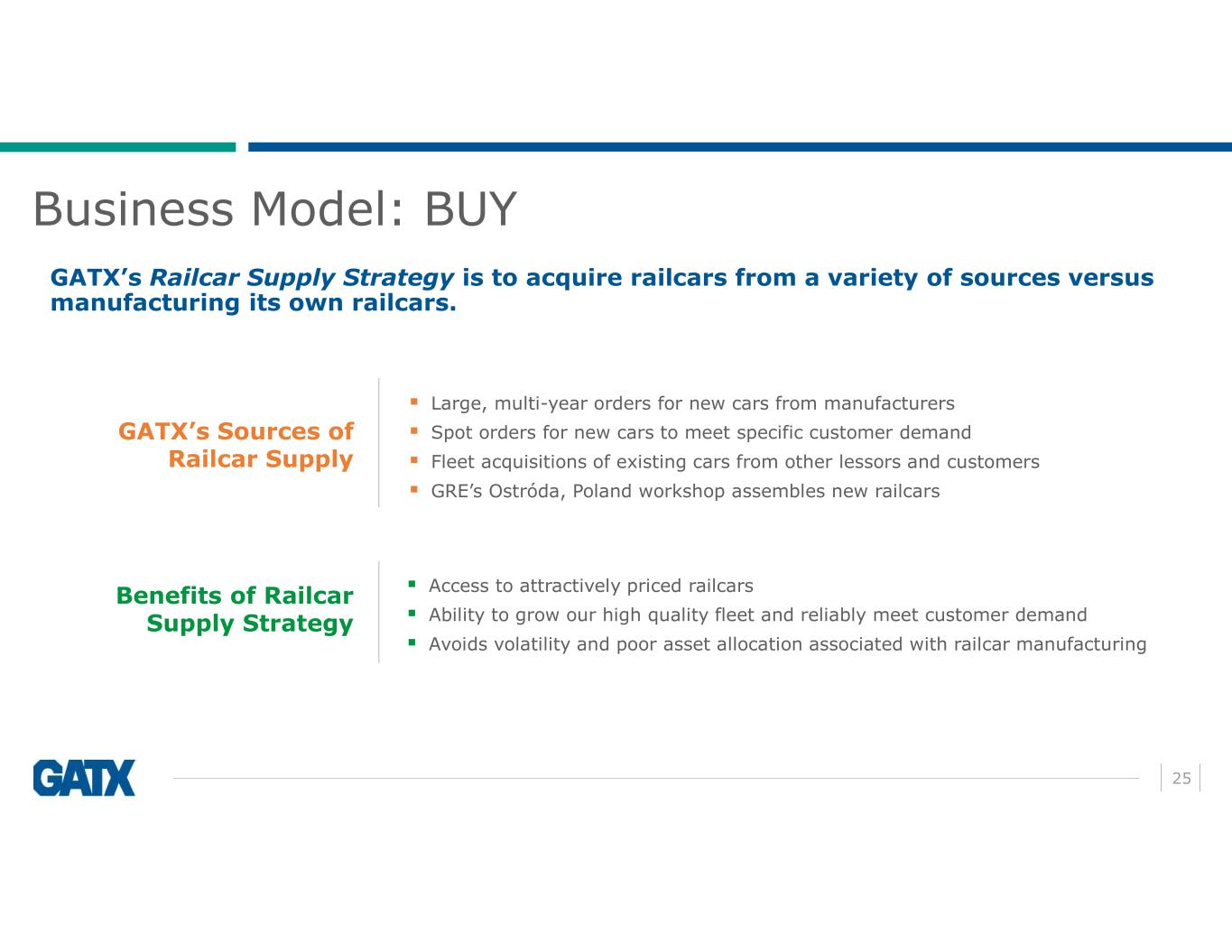
25 GATX’s Sources of Railcar Supply Benefits of Railcar Supply Strategy Large, multi-year orders for new cars from manufacturers Spot orders for new cars to meet specific customer demand Fleet acquisitions of existing cars from other lessors and customers GRE’s Ostróda, Poland workshop assembles new railcars Access to attractively priced railcars Ability to grow our high quality fleet and reliably meet customer demand Avoids volatility and poor asset allocation associated with railcar manufacturing GATX’s Railcar Supply Strategy is to acquire railcars from a variety of sources versus manufacturing its own railcars. Business Model: BUY

Customers prefer GATX because of its diverse fleet, technical expertise to meet unique needs, and superior ongoing service. 26 HIGH FLEET UTILIZATION Focus on utilization, adjusting rate and term to capture maximum value throughout cycles Maintenance service capabilities preferred by customers Utilization remained 98%+ for over a decade CAR AVAILABILITY Most diverse fleet in the industry can satisfy varying customer demands Utilize multi-year committed orders with railcar manufacturers to maintain a steady stream of new car deliveries DELIVERY Develop lease structures that fit customers’ needs New Car Inspection Group reviews new railcars against GATX and customers’ specifications before acceptance STRONG CUSTOMER RELATIONSHIPS High-quality and diverse base of over 850 customers Long-term customer relationships; average tenure of top 10 customers is 50 years CUSTOMER VALUE Business Model: LEASE

GATX has built a strong market position by focusing on full-service leasing in North America and Europe. 27 MAINTENANCE Customers rely on GATX to manage the complex process of maintaining railcars Premium service minimizes railcar quality issues and unexpected downtime Extensive maintenance network: nine facilities in North America and Europe In 2020, GATX performed an aggregate of approximately 68,000 maintenance events in its owned and third-party maintenance network in North America and Europe ENGINEERING GATX’s engineering team consists of mechanical, structural, and chemical engineers GATX’s engineers tailor railcar solutions to meet customers’ needs, taking into consideration commodity carried, location, and layout of facilities Develops railcar modification programs TRAINING GATX provides important training to customers and first responders GATX offers training at its headquarters, at customer sites, and through its TankTrainer™ mobile classroom TECHNOLOGY MyGATXRail.com provides customers with real-time fleet management capability and maintenance data Shop Portal provides GATX personnel with state-of-the- art technology for car inspection, maintenance instructions, and reporting in real-time RailPulse℠ joint venture intended to facilitate the adoption of telematics across the North American railcar fleet REGULATORY As a full-service railcar lessor, GATX takes an active leadership role in the complex regulatory landscape GATX leads several industry groups and agencies in North America and Europe Business Model: SERVICE As of 12/31/2020

REMARKETING INCOME (Income from sale of owned assets) Helps to optimize a diversified, high-performing railcar fleet Over the last 10 years, GATX Rail North America generated an average of approximately $51 million of remarketing income per year SCRAPPING GAINS GATX typically realizes gains when railcars are scrapped at the end of their useful lives Over the last 10 years, GATX Rail North America and Rail International generated an average of approximately $12 million of scrapping gains per year GATX optimizes its fleet partly through selling railcars in the secondary market or scrapping them at the end of their useful lives. Our fleet of cost-advantaged, well-maintained modern railcars, leased to quality customers, allows us to realize significant remarketing income when we decide to sell cars in the secondary market. 28 Rail North America and Rail International 2011 2012 2013 2014 2015 2016 2017 2018 2019 2020 Approximate # of railcars scrapped 3,700 2,700 3,100 3,200 2,600 3,900 4,800 3,400 3,300 2,400 Scrapping gains/(loss) ($ millions) $27.0 $19.2 $20.7 $16.1 $9.5 $3.2 $8.5 $14.5 $(2.3)* $0.1 Rail North America 2011 2012 2013 2014 2015 2016 2017 2018 2019 2020 Approximate # of railcars sold 1,800 2,000 3,700 2,700 3,900 2,700 1,600 3,200 3,600 1,600 Remarketing income ($ millions) $27.4 $45.7 $54.5 $62.6 $67.4 $46.3 $44.6 $66.1 $58.9 $39.2 *Includes a $3.8 million scrap loss on customer damaged cars that was largely offset by an early termination fee Business Model: MAXIMIZE
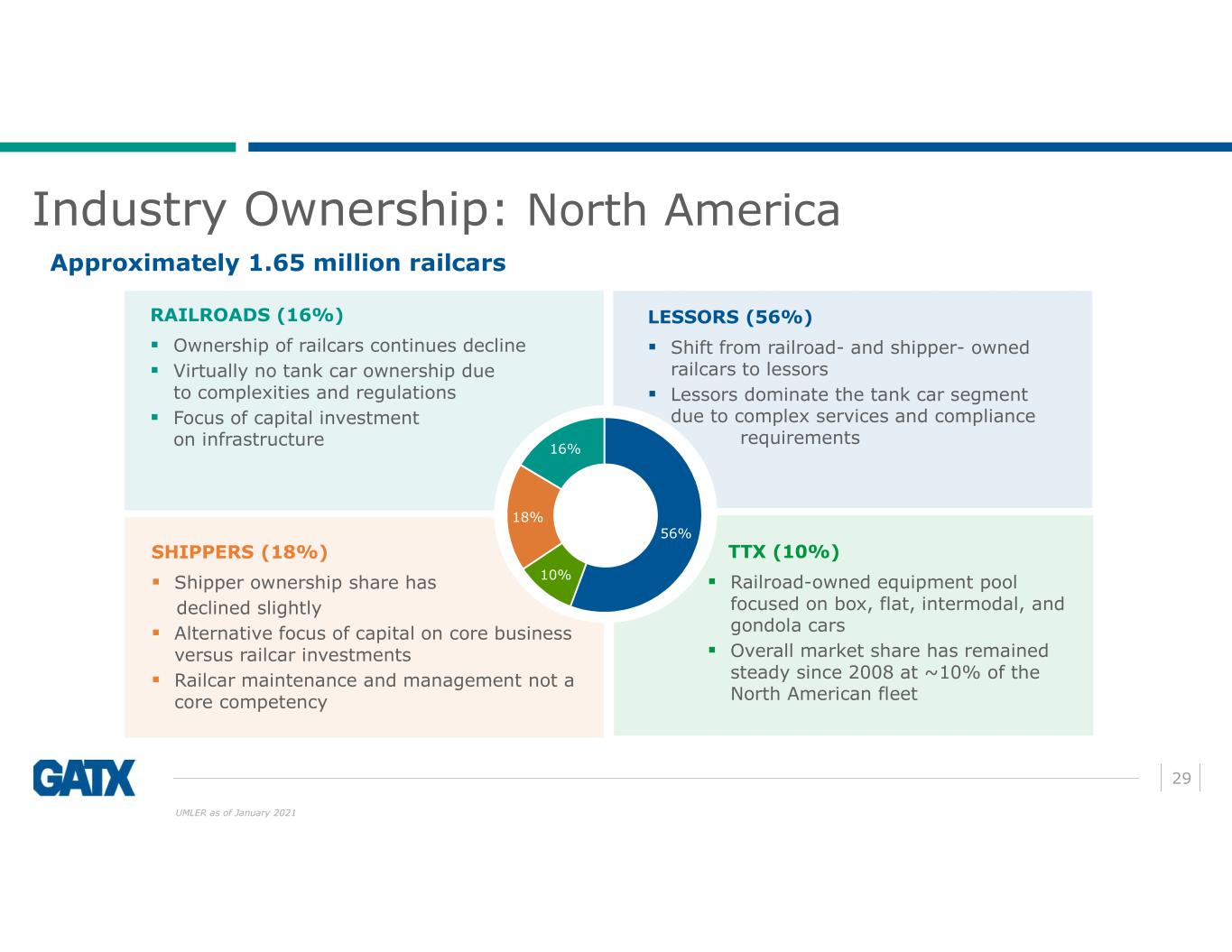
RAILROADS (16%) Ownership of railcars continues decline Virtually no tank car ownership due to complexities and regulations Focus of capital investment on infrastructure LESSORS (56%) Shift from railroad- and shipper- owned railcars to lessors Lessors dominate the tank car segment due to complex services and compliance requirements SHIPPERS (18%) Shipper ownership share has declined slightly Alternative focus of capital on core business versus railcar investments Railcar maintenance and management not a core competency TTX (10%) Railroad-owned equipment pool focused on box, flat, intermodal, and gondola cars Overall market share has remained steady since 2008 at ~10% of the North American fleet 56% 10% 18% 16% Approximately 1.65 million railcars Industry Ownership: North America UMLER as of January 2021 29
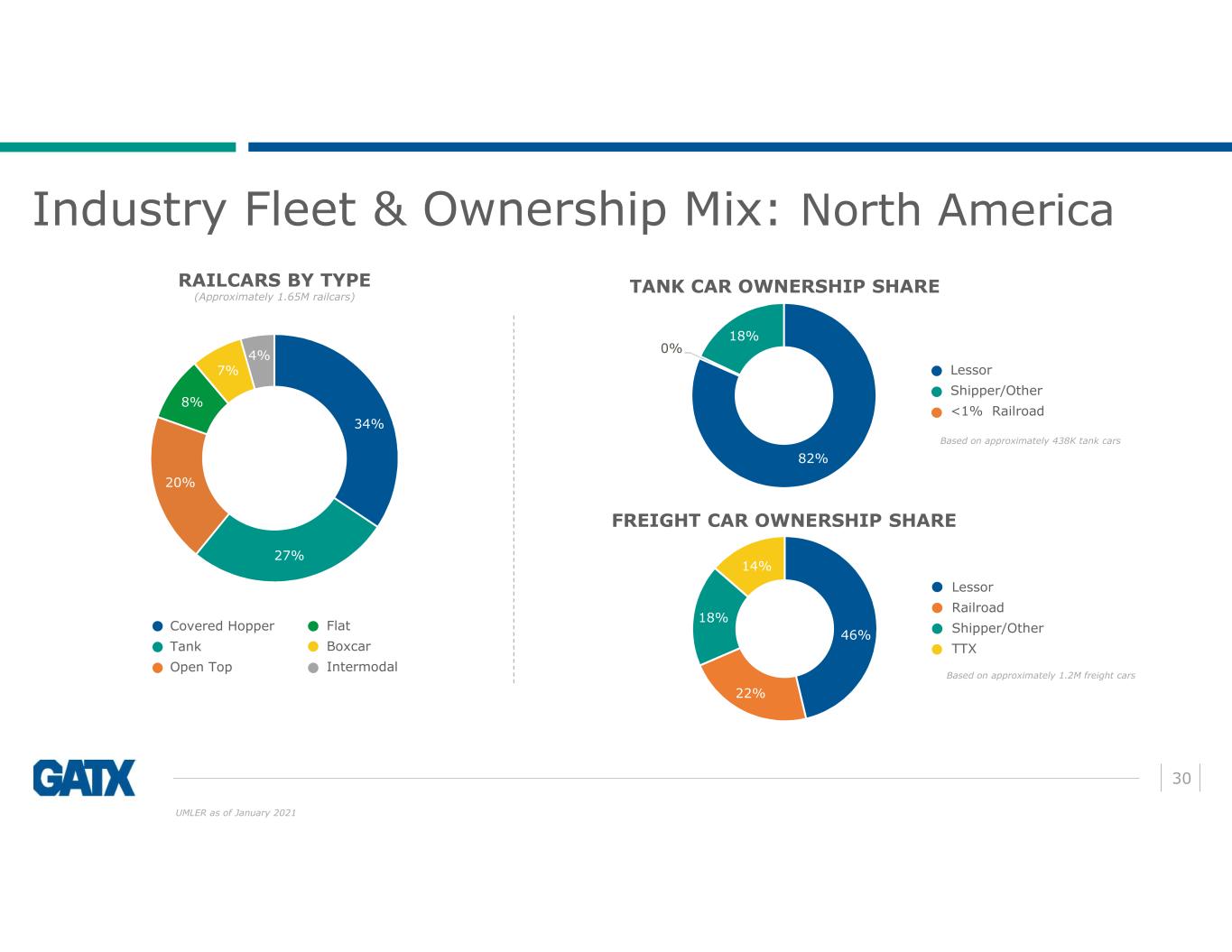
Covered Hopper Tank Open Top Flat Boxcar Intermodal Based on approximately 438K tank cars Lessor Shipper/Other <1% Railroad Based on approximately 1.2M freight cars 46% 22% 18% 14% Lessor Railroad Shipper/Other TTX 34% 27% 20% 8% 7% 4% 82% 0% 18% RAILCARS BY TYPE (Approximately 1.65M railcars) TANK CAR OWNERSHIP SHARE FREIGHT CAR OWNERSHIP SHARE UMLER as of January 2021 Industry Fleet & Ownership Mix: North America 30

11% 24% 15%11%5% 34% 17% 33% 18% 10% 7% 15% 13% 16% 14% 14% 13% 6% 24% 13% GATX GATX Wells Fargo Rail Union Tank Car Trinity CIT SMBC Other 17% GATX GATX Union Tank Car Trinity CIT SMBC Other Based on approximately 358K lessor-owned tank cars 11% GATX GATX Wells Fargo Rail CIT Trinity SMBC Other Based on approximately 561K lessor-owned freight cars LESSOR OWNERSHIP SHARE (Based on approximately 919K lessor-owned railcars) TANK CAR LESSOR OWNERSHIP SHARE FREIGHT CAR LESSOR OWNERSHIP SHARE UMLER as of January 2021 31 Lessor Market Share: North America

INDUSTRY SHIPMENT COMPOSITION* (Based on 2020 U.S and Canadian carloads of approximately 15.2M) 32 21.2 20.4 18.6 18.7 19.4 16.9 17.9 15.2 14 15 16 17 18 19 20 21 22 2006 2008 2010 2012 2014 2016 2018 2020 M IL LI O N S 23% 16% 15% 6% 6% 5% 3% 3% 22% Coal & Coke Farm Products Chemicals Petroleum Products Auto Forest & Paper Products Metals Food / Kindred All Other CARLOADS ORIGINATED (United States and Canada) *Association of American Railroads for 52 weeks ending 12/26/2020 32 Industry Shipments & Carloadings: North America

North America – Industry Railcar Deliveries Number of Tank Number of Freight ’05 ’06 ’07 ’08 ’09 ’10 ’11 ’12 ’13 ’14 ’15 ’16 ’17 ’18 ’19 ’20 ‘21 - 5,000 10,000 15,000 20,000 25,000 YTD thru 2Q21 Total: ~13k Railway Supply Institute as of July 2021 33

North America – Industry Railcar Orders Number of Tank Number of Freight ’05 ’06 ’07 ’08 ’09 ’10 ’11 ’12 ’13 ’14 ’15 ’16 ’17 ’18 ’19 ’20 ‘21 - 5,000 10,000 15,000 20,000 25,000 30,000 35,000 40,000 45,000 50,000 YTD thru 2Q21 Total: ~16k Railway Supply Institute as of July 2021 34

26% 40% 14% 20% As of 12/31/2020 Note: Customer families sometimes include more than one customer account; the S&P or equivalent ratings noted generally reflect the credit quality of the rated parent entity. Lease obligations of subsidiaries are not necessarily guaranteed by the rated parent entity. GATX serves more than 850 individual customers Top 20 customers account for less than 35% of lease revenue Average relationship tenure of top 10 customers is 50 years Largest customer represents less than 5% of total lease revenue BB+ or lower Private / Not Rated AAA, AA, & A BBB CREDIT RATINGS OF TOP 50 CUSTOMER FAMILIES 35 GATX Rail NA: Diverse Customer Portfolio

CAR TYPE COMMODITIES CARRIED % OF FLEET % OF NBV TA N K C A R S FR E IG H T C A R S High-Pressure Tank Cars LPG, VCM, Propylene, Carbon dioxide General Service Tank Cars: Molten sulfur, Clay slurry, Caustic soda, Corn syrup 13k-19k gallon Other Specialty Tank Cars Acids (sulfuric, hydrochloric, phosphoric, acetic, nitric, etc.), Coal tar pitch, Specialty chemicals Total Tank Boxcars Paper products, Lumber, Canned goods, Food and beverages Pneumatic Covered Hoppers Plastic pellets Gravity Covered Hoppers: Sand, Cement, Roofing granules, Fly ash, Dry chemicals <4k cubic feet Pressure Differential Flour, Corn starch, Mineral powder, Lime, Clay, Cement Covered Hoppers Other Flat cars (lumber and steel), Intermodal (containerized goods), Automotive (finished vehicles) Total Freight General Service Tank Cars: Liquid fertilizers, Fuel oils, Asphalt, Food-grade oils, Chemicals (styrene, glycols, etc.) 20k-25k gallon 15.1% 13.7% General Service Tank Cars: Ethanol & methanol, Food-grade oils, Lubricating oils, Light chemicals, >25k gallon Light petroleum products (crude oil, fuel oils, diesels, gasoline, etc.) 16.1% 23.6% 10.4% 11.0% 6.0% 6.5% 4.8% 4.2% 52.4% 59.0% 12.1% 5.5% Open-top Cars Aggregates, Coal, Coke, Woodchips, Scrap metal, Steel coils 6.7% 5.5% Gravity Covered Hoppers: Grain, Sugar, Fertilizer, Potash, Lime, Soda ash, Bentonite >4k cubic feet 10.5% 10.5% 5.4% 3.0% 4.3% 4.3% 2.7% 2.5% 5.9% 9.7% 47.6% 41.0% 36 GATX Rail NA: Diverse Fleet As of 12/31/2020
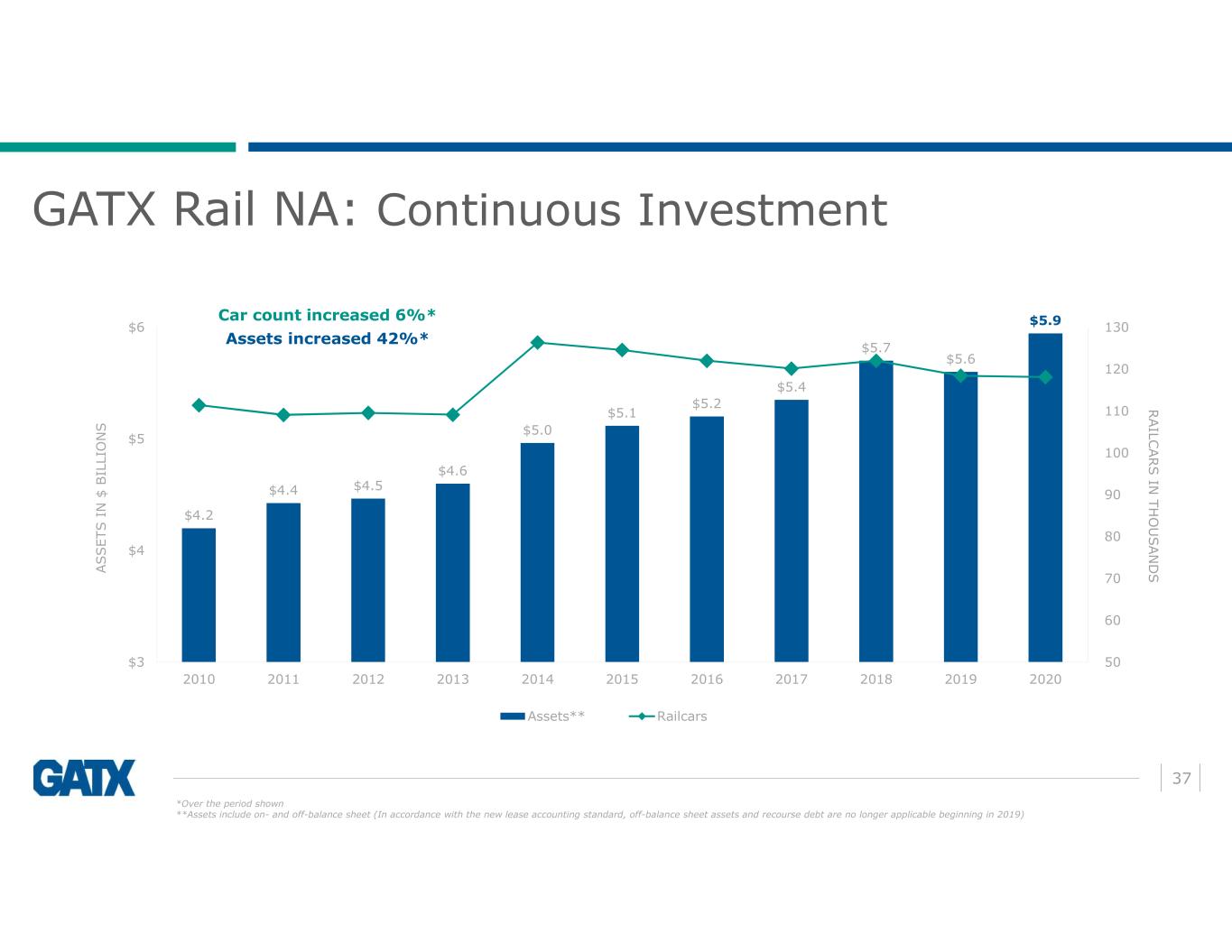
$4.2 $4.4 $4.5 $4.6 $5.0 $5.1 $5.2 $5.4 $5.7 $5.6 $5.9 50 60 70 80 90 100 110 120 130 $3 $4 $5 $6 2010 2011 2012 2013 2014 2015 2016 2017 2018 2019 2020 Assets** Railcars A S S E T S I N $ B IL LI O N S R A ILC A R S IN T H O U S A N D S Car count increased 6%* Assets increased 42%* 37 GATX Rail NA: Continuous Investment *Over the period shown **Assets include on- and off-balance sheet (In accordance with the new lease accounting standard, off-balance sheet assets and recourse debt are no longer applicable beginning in 2019)

GATX is known for integrity, safety, and quality of our operations and superior execution. Services range from routine maintenance and regulatory programs to car modifications and rebuilds, including all mechanical repairs, interior cleaning, interior/exterior blasting, interior/exterior coatings, valve maintenance and qualification, and more. EXTENSIVE MAINTENANCE NETWORK Eight maintenance facilities Seven locations with mobile units Six customer site locations MAINTENANCE CUSTOMERS RELY ON GATX In 2020, performed approximately 48,000 maintenance events in its owned and third-party maintenance network Directing an increased percentage of work to GATX-owned shops; improves safety, quality, delivery, and cost metrics 38 GATX Rail NA: Maintenance Network As of 12/31/2020
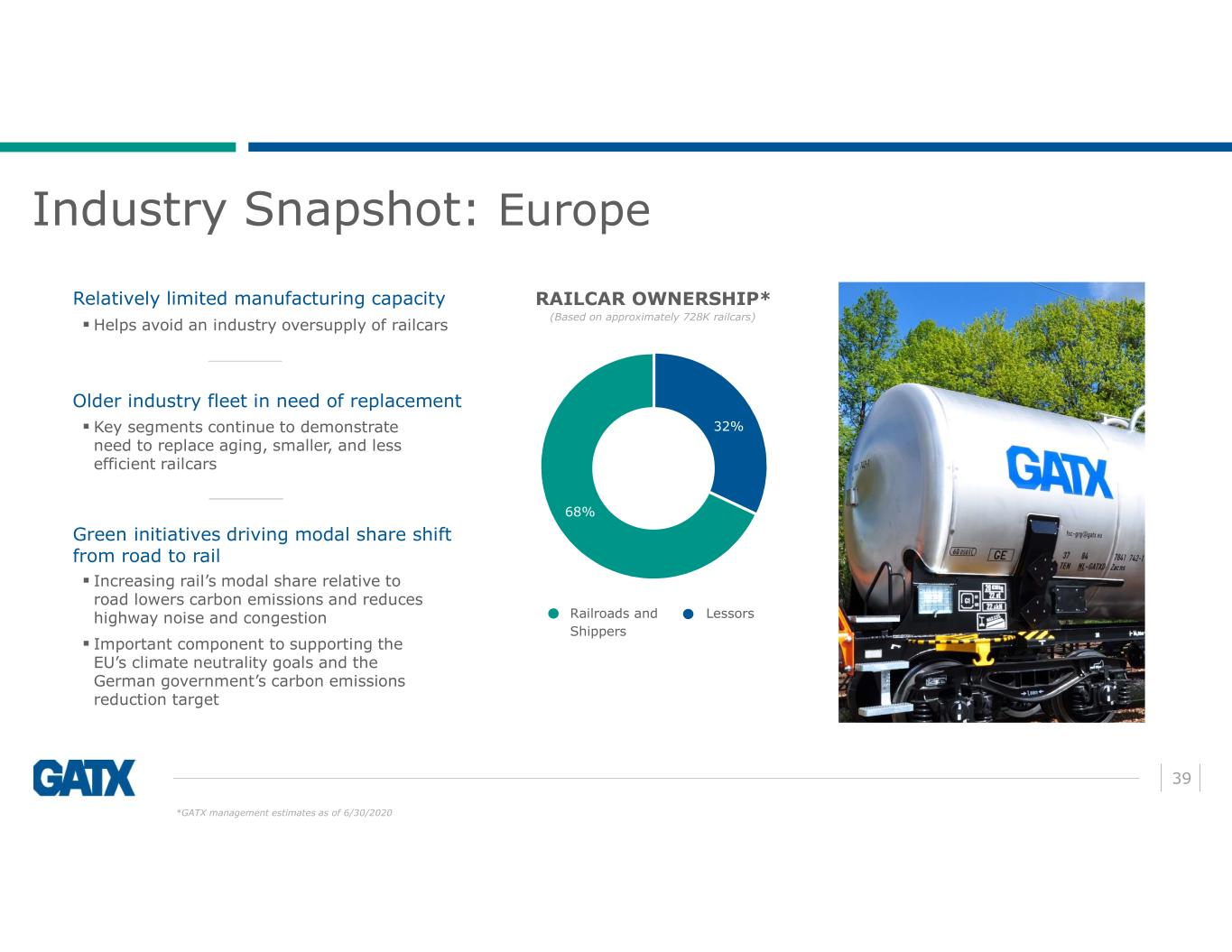
32% 68% (Based on approximately 728K railcars) RAILCAR OWNERSHIP* Railroads and Shippers Lessors 39 Industry Snapshot: Europe Relatively limited manufacturing capacity Helps avoid an industry oversupply of railcars Older industry fleet in need of replacement Key segments continue to demonstrate need to replace aging, smaller, and less efficient railcars Green initiatives driving modal share shift from road to rail Increasing rail’s modal share relative to road lowers carbon emissions and reduces highway noise and congestion Important component to supporting the EU’s climate neutrality goals and the German government’s carbon emissions reduction target *GATX management estimates as of 6/30/2020

24% 76% 70% 30% 31% 19% 35% 11% 4% Flat Wagons Tank Wagons Dry Bulk Wagons Covered Wagons Other Based on approximately 136K tank cars Lessors Railroad & Privately Owned Based on approximately 592K freight cars Lessor Railroad & Privately Owned RAILCARS BY TYPE (Approximately 728K railcars) TANK CAR OWNERSHIP SHARE FREIGHT CAR OWNERSHIP SHARE Industry Fleet and Ownership Mix: Europe 40 GATX management estimates as of 6/30/2020

3% 39% 21% 7% 5% 25% 23% 33%13% 8% 2% 21% 11% 36% 18% 6% 5% 24% 11% GRE 23% GRE Based on approximately 95K lessor-owned tank cars 3% GRE Based on approximately 141K lessor-owned freight cars LESSOR OWNERSHIP SHARE (Based on approximately 236K lessor-owned railcars) TANK CAR LESSOR OWNERSHIP SHARE FREIGHT CAR LESSOR OWNERSHIP SHARE 41 Lessor Market Share: Europe GATX Rail Europe (GRE) VTG Ermewa Wascosa Touax Other GRE VTG Ermewa Wascosa Touax Other GRE VTG Ermewa Touax Wascosa Other GATX management estimates as of 6/30/2020

CAR TYPE COMMODITIES CARRIED Mineral Oil Light mineral oil (gasoline, jet fuel, diesel oils, light heating oils), Dark mineral oil (heavy heating oils, lubricating oils, coal tar, bitumen, asphalt), Crude oil, Bio diesel, Styrene, Acetone, Methanol, Ethanol Liquefied Petroleum Gas (LPG) Propane, Butane, Propylene, Butadiene, Light carbohydrate fractions, Cooling gas mixtures, Chloromethanes Chemicals Liquid fertilizers, Acids (Hydrochloric, Sulphur, Phosphoric, etc.), Bases (Carbohydrates, Solutions, Soda lye, Sodium Hypochlorite, etc.), Aromatics (Benzene, Toluene, Xylenes, Phenol, etc.), Liquid sulphur, Hydrogen peroxide, Resins and glues, Solvents Freight and Intermodal Containers/Trailers, Steel coils, Timber, Lime, Cement, Coal, Coke, Gravel, Sand, Silica sand 71% of GRE’s revenue is generated in Germany, Poland, and Austria – strong rail freight transport economies. 30% 30% 11% 5% 4% 4% 4% 12% 52% 17% 14% 17% 42 Approximately 26.3K railcars as of 12/31/2020Based on 2020 GRE Revenues GEOGRAPHIES SERVED FLEET STRUCTURE Mineral Oil LPG Chemicals Freight & Intermodal Germany Poland Austria Switzerland 42 GATX Rail Europe (GRE): Major Rail Markets The Netherlands Czech Republic Hungary Other

70% 5% 25% GRE’s newer and higher capacity railcar fleet attracts top-tier customers. 43 Top 20 customers based on 2020 revenue Investment Grade Speculative (BB+ or lower) Private/Not Rated 43 GRE: Diverse Customer Portfolio & Fleet As of 12/31/2020 2010 2020 GRE Car Count 20,400+ 26,300+ GRE Average Fleet Age (years) 24 17 GRE Fleet Capacity (thousand m³) 1,524 2,187 TOP 20 CUSTOMER CREDIT RATING GRE HAS INVESTED >$1.3B OVER THE LAST 10 YEARS Today, the average remaining lease term for GRE is 22 months • Renewal success rates for GRE fleet have been consistently high • Eight of GRE’s top ten customers have done business with us for over 20 years, with five customers for 30 years The focus on investments in freight and intermodal segments continued throughout 2020 as the related fleet grew by 1,215 cars (+39.2%), followed by LPG (+6.3%) and Chemical fleets (+7.6%) with ~265 cars each
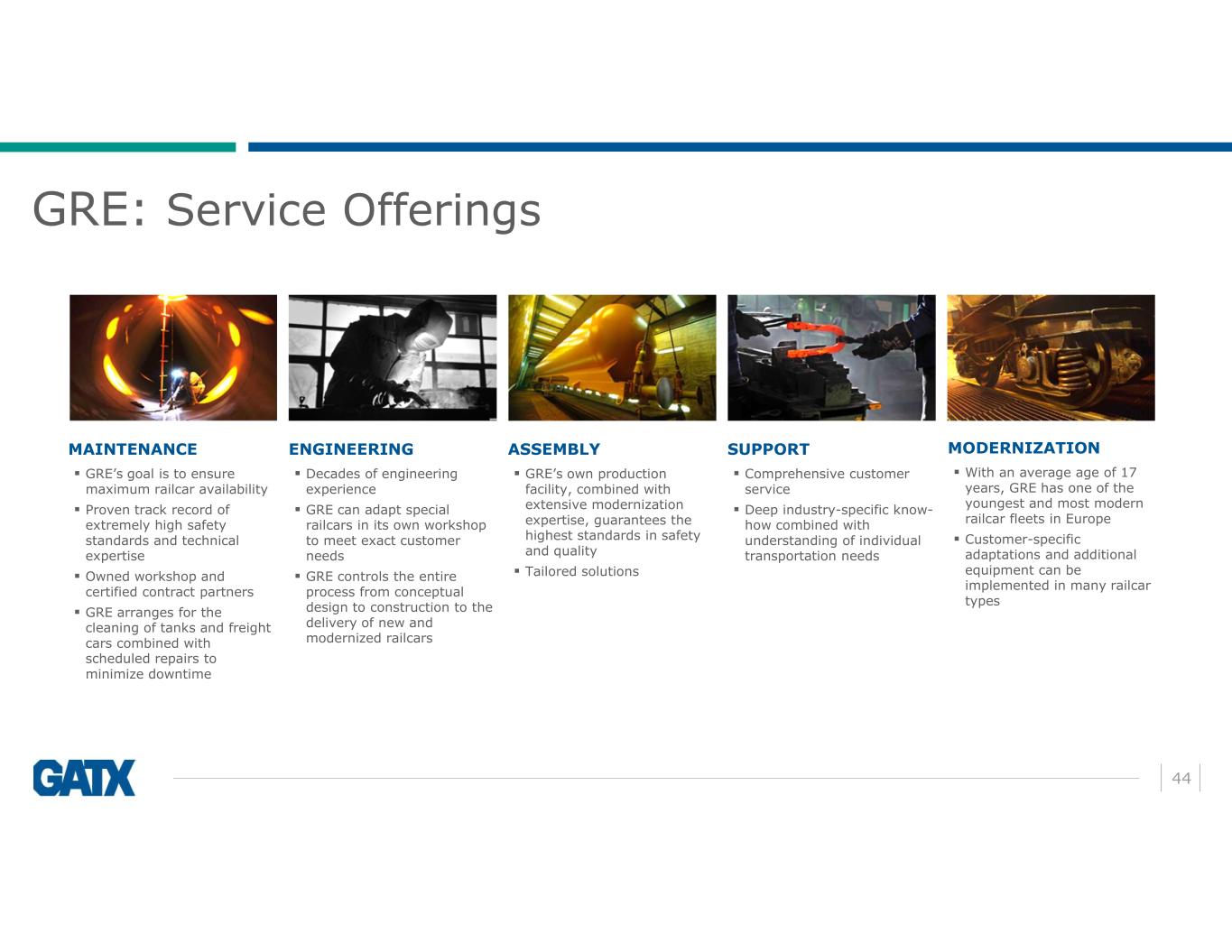
MODERNIZATION With an average age of 17 years, GRE has one of the youngest and most modern railcar fleets in Europe Customer-specific adaptations and additional equipment can be implemented in many railcar types SUPPORT Comprehensive customer service Deep industry-specific know- how combined with understanding of individual transportation needs ASSEMBLY GRE’s own production facility, combined with extensive modernization expertise, guarantees the highest standards in safety and quality Tailored solutions ENGINEERING Decades of engineering experience GRE can adapt special railcars in its own workshop to meet exact customer needs GRE controls the entire process from conceptual design to construction to the delivery of new and modernized railcars MAINTENANCE GRE’s goal is to ensure maximum railcar availability Proven track record of extremely high safety standards and technical expertise Owned workshop and certified contract partners GRE arranges for the cleaning of tanks and freight cars combined with scheduled repairs to minimize downtime 44 GRE: Service Offerings
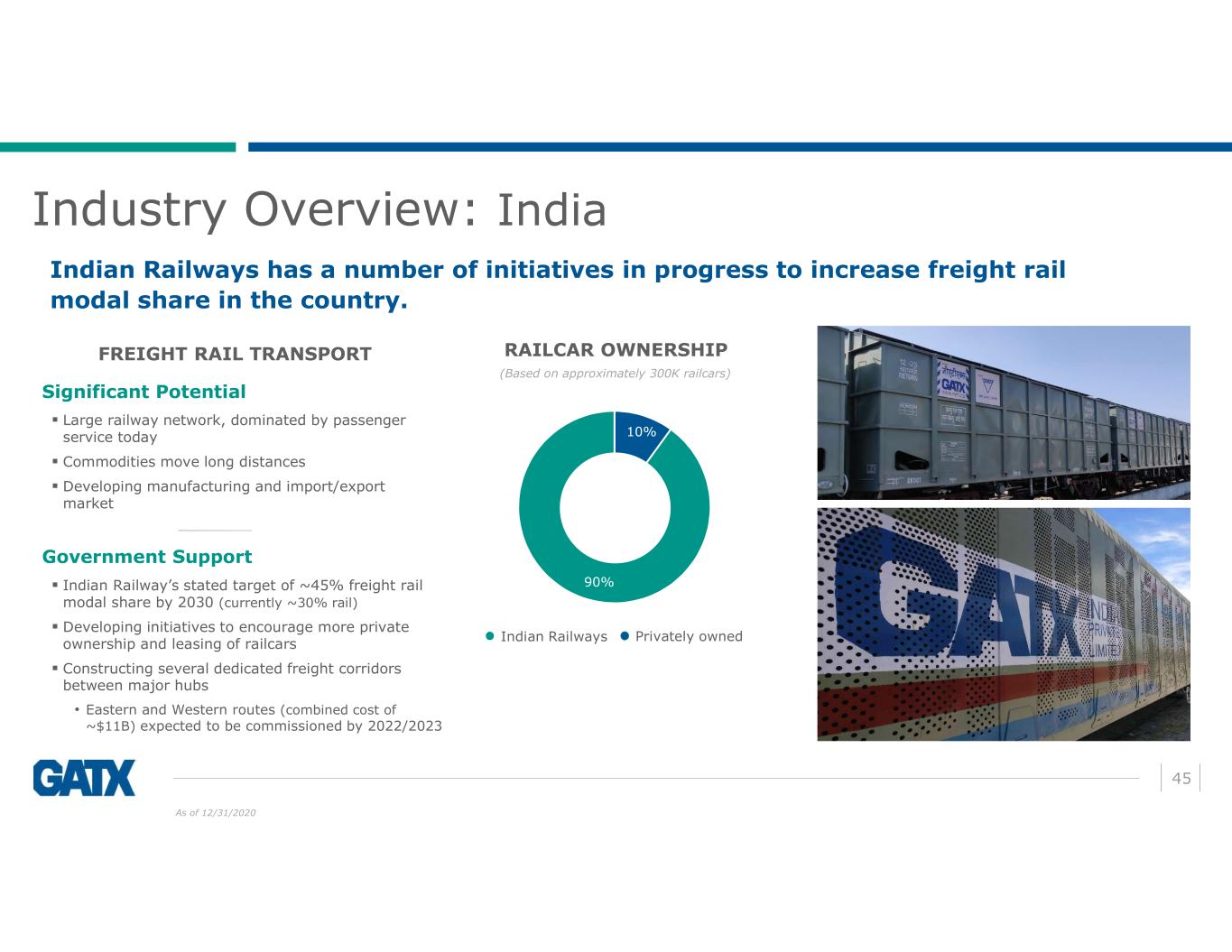
Indian Railways has a number of initiatives in progress to increase freight rail modal share in the country. 45 Industry Overview: India As of 12/31/2020 Significant Potential Large railway network, dominated by passenger service today Commodities move long distances Developing manufacturing and import/export market Government Support Indian Railway’s stated target of ~45% freight rail modal share by 2030 (currently ~30% rail) Developing initiatives to encourage more private ownership and leasing of railcars Constructing several dedicated freight corridors between major hubs • Eastern and Western routes (combined cost of ~$11B) expected to be commissioned by 2022/2023 FREIGHT RAIL TRANSPORT Privately ownedIndian Railways 10% 90% (Based on approximately 300K railcars) RAILCAR OWNERSHIP

1% 10% 40% 50% 1990 1998 2016 2019* PERCENT OF INDUSTRY’S SPARE ENGINES LEASED 46 *RRPF management estimate as of 02/24/2021 Aircraft Spare Engine Leasing Industry Overview Aircraft spare engines are attractive and reliable leasing assets Robust residual value characteristics Retain value better over the long term compared to aircraft Aircraft engines need regular scheduled maintenance (3-5 year intervals) which takes between 90 and 120 days Correct level of spare engines are maintained to ensure the fleet remains operationally undisrupted Spare engine ratio to engines installed on aircraft recommended by manufacturers • 8-10% narrow body • 10-15% wide body Percentage of leased vs. owned aircraft spare engines by airlines has increased over time

Aircraft Spare Engine Leasing Industry Overview 0 1 2 3 4 5 1980 1985 1990 1995 2000 2005 2010 2015 2020 World Air Passenger Traffic Evolution, 1980-2020 Total Domestic International 47 Most industry experts anticipate global air travel to fully recover by 2024 or earlier. C O V ID -1 9 Fin an cial C risis S A R S 9 /1 1 A ttacks A sian Fin an cial C risis G u lf W ar B ill io n p a ss en g er s Chart – Source: IEA (Last updated 4 Dec 2020) World air passenger traffic evolution, 1980-2020, IEA, Paris https://www.iea.org/data-and-statistics/charts/world-air-passenger-traffic-evolution-1980-2020. All rights reserved.

The RRPF affiliates portfolio has contractual future lease receipts of over $2.7B. GATX established its first partnership with Rolls-Royce plc in 1998 Total NBV of engines has grown at a CAGR of 14.5% since RRPF’s establishment; today the NBV is nearly $4.8B RRPF affiliates lease aircraft spare engines to commercial airlines and Rolls-Royce plc • RRPF generates additional revenue from third-party asset management, a relatively small but important part of the business $0 $100 $200 $300 $400 $500 $0 $1 $2 $3 $4 $5 N B V ( B IL LI O N S ) R E V E N U E (M ILLIO N S ) NBV Total Annual Revenue NBV: 14.5% Rev: 13.7% CAGR since 1998 RRPF Growth in Revenue & NBV 48 RRPF Affiliates Overview As of 12/31/2020 All aircraft spare engine images used in this presentation ©Rolls-Royce 2021 OVERVIEW (100% Basis)

Tank containers transport a variety of liquids as well as gases in bulk Tank container fleet growth has increased steadily alongside consistent growth of global liquid trade volumes in recent decades Benefits of tank containers relative to other global liquid transport asset types (e.g. drums and flexitanks) include: • More sustainable and environmentally friendly (e.g. longer lifespan, smaller spillage risk) • Better cost efficiency • Less labor intensive The majority of tank containers are manufactured in China 0 200,000 400,000 600,000 800,000 2013 2014 2015 2016 2017 2018 2019 2020 2021 GLOBAL TANK CONTAINER FLEET GROWTH* CAGR of 9.3% 49 Tank Container Industry Snapshot *International Tank Container Organization 2021 Global Tank Container Fleet Survey

INDUSTRY OWNERSHIP (Based on global tank container fleet of approximately 686K) Source: International Tank Container Organization, 2021 Global Tank Container Fleet Survey 1Includes owned and managed tank containers 2Includes Raffles Leasing 46% 54% Lessors1 TOP LESSORS OWNERSHIP SHARE1 (Based on approximately 316.7K tank containers in leasing company fleets) 6% 21% 21% 14% 6% 4% 4% 2% 2% 20% Trifleet EXSIF Worldwide Eurotainer2 Seaco Global CS Leasing Triton Intl. GEM Containers Peacock Container Albatross Tank Leasing Others Operators & Shippers Trifleet 6% 50 Industry Ownership Mix & Lessor Market Share
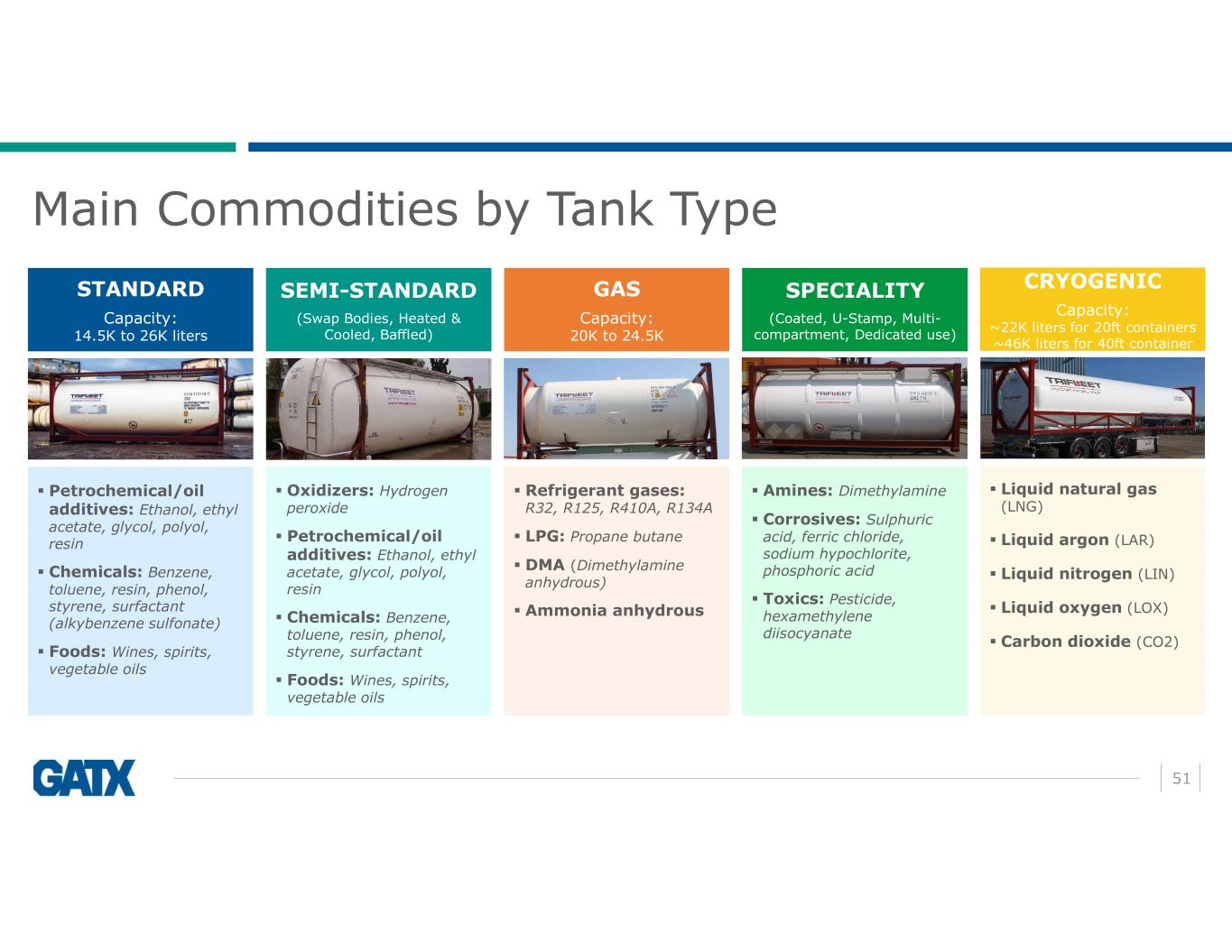
51 Main Commodities by Tank Type STANDARD Capacity: 14.5K to 26K liters SEMI-STANDARD (Swap Bodies, Heated & Cooled, Baffled) GAS Capacity: 20K to 24.5K SPECIALITY (Coated, U-Stamp, Multi- compartment, Dedicated use) CRYOGENIC Capacity: ~22K liters for 20ft containers ~46K liters for 40ft container Petrochemical/oil additives: Ethanol, ethyl acetate, glycol, polyol, resin Chemicals: Benzene, toluene, resin, phenol, styrene, surfactant (alkybenzene sulfonate) Foods: Wines, spirits, vegetable oils Oxidizers: Hydrogen peroxide Petrochemical/oil additives: Ethanol, ethyl acetate, glycol, polyol, resin Chemicals: Benzene, toluene, resin, phenol, styrene, surfactant Foods: Wines, spirits, vegetable oils Refrigerant gases: R32, R125, R410A, R134A LPG: Propane butane DMA (Dimethylamine anhydrous) Ammonia anhydrous Amines: Dimethylamine Corrosives: Sulphuric acid, ferric chloride, sodium hypochlorite, phosphoric acid Toxics: Pesticide, hexamethylene diisocyanate Liquid natural gas (LNG) Liquid argon (LAR) Liquid nitrogen (LIN) Liquid oxygen (LOX) Carbon dioxide (CO2)

RECONCILIATION OF NON-GAAP MEASURES

53 Reconciliation of Non-GAAP Measure Net Income Measures Net Income (in millions) 2011 2012 2013 2014 2015 2016 2017 2018 2019 2020 Net income (GAAP) 110.8$ 137.3$ 169.3$ 205.0$ 205.3$ 257.1$ 502.0$ 211.3$ 211.2$ 151.3$ Less: Net income from discontinued operations (GAAP) n/a n/a n/a n/a n/a n/a 34.2 20.8 30.4 1.1 Net income from continuing operations (GAAP) 110.8$ 137.3$ 169.3$ 205.0$ 205.3$ 257.1$ 467.8$ 190.5$ 180.8$ 150.2$ Adjustments attributable to pre-tax income from continuing operations: Cost attributable to the closure of a maintenance facility at Rail International - - - - - - - 9.5 - - Net loss (gain) on wholly owned Portfolio Management marine investments - - - - 9.2 2.5 (1.8) - - - Railcar impairment at Rail North America - - - - - 29.8 - - - - Residual sharing settlement at Portfolio Management - - - - - (49.1) - - - - Early retirement program - - - - 9.0 - - - - - Litigation recoveries (3.2) - - - - - - - - - Leveraged lease adjustment (5.5) - - - - - - - - - Total adjustments attributable to pre-tax income from continuing operations (8.7)$ -$ -$ -$ 18.2$ (16.8)$ (1.8)$ 9.5$ -$ -$ Income taxes thereon, based on applicable effective tax rate 2.0$ -$ -$ -$ (6.9)$ 7.2$ 0.7$ (3.1)$ -$ -$ Other income tax adjustments attributable to income from continuing operations: Income tax rate changes - 0.7 - - 14.1 - - - (2.8) Impact of the Tax Cuts and Jobs Act of 2017 - - - - - - (293.2) (16.7) - - Foreign tax credit utilization - (4.6) (3.9) - - (7.1) - (1.4) - - GATX income taxes on sale of AAE - - 23.2 - - - - - - - Tax benefits upon close of tax audits (4.8) (15.5) - - - - - - - - Total other income tax adjustments attributable to income from continuing operations (4.8)$ (19.4)$ 19.3$ -$ 14.1$ (7.1)$ (293.2)$ (18.1)$ (2.8)$ -$ Adjustments attributable to affiliates' earnings from continuing operations, net of taxes: Income tax rate changes (4.1) (4.6) (7.6) - (7.7) (3.9) - - - 12.3 Net loss (gain) on Portfolio Management marine affiliate - - - - 11.9 (0.6) - - - - Pre-tax gain on sale of AAE - - (9.3) - - - - - - - Interest rate swaps at AAE (0.2) 20.5 (6.9) - - - - - - - Total adjustments attributable to affiliates' earnings from continuing operations, net of taxes (4.3)$ 15.9$ (23.8)$ -$ 4.2$ (4.5)$ -$ -$ -$ 12.3$ Net Income from continuing operations, excluding tax adjustments and other items (non-GAAP) 95.0$ 133.8$ 164.8$ 205.0$ 234.9$ 235.9$ 173.5$ 178.8$ 178.0$ 162.5$ Note: The information for 2011-2016 in the tables above has not been recast for discontinued operations presentation.

54 Reconciliation of Non-GAAP Measures Net Income Measures (cont.) and Earnings Per Share Net Income (in millions) 2011 2012 2013 2014 2015 2016 2017 2018 2019 2020 Adjustments attributable to discontinuing operations, net of taxes: Net casualty gain at ASC n/a n/a n/a n/a n/a n/a - - (8.1) - Impact of the Tax Cuts and Jobs Act of 2017 n/a n/a n/a n/a n/a n/a (22.7) 0.2 - - Total adjustments attributable to discontinued operations, net of taxes n/a n/a n/a n/a n/a n/a (22.7)$ 0.2$ (8.1)$ -$ Net income from discontinued operations, excluding tax adjustments and other items (non-GAAP) n/a n/a n/a n/a n/a n/a 11.5$ 21.0$ 22.3$ 1.1$ Net income from consolidated operations, excluding tax adjustments and other items (non-GAAP) 95.0$ 133.8$ 164.8$ 205.0$ 234.9$ 235.9$ 185.0$ 199.8$ 200.3$ 163.6$ Note: The information for 2011-2016 in the tables above has not been recast for discontinued operations presentation. Earnings per Share 2011 2012 2013 2014 2015 2016 2017 2018 2019 2020 Diluted earnings per share from continuing operations (GAAP) 2.35$ 2.88$ 3.59$ 4.48$ 4.69$ 6.29$ 11.88$ 4.98$ 4.97$ 4.24$ Diluted earnings per share from discontinued operations (GAAP) n/a n/a n/a n/a n/a n/a 0.87 0.54 0.84 0.03 Diluted earnings per share from consolidated operations (GAAP) 2.35$ 2.88$ 3.59$ 4.48$ 4.69$ 6.29$ 12.75$ 5.52$ 5.81$ 4.27$ Diluted earnings per share from continuing operations, excluding tax adjustments and other items (non-GAAP) 2.01$ 2.81$ 3.50$ 4.48$ 5.37$ 5.77$ 4.41$ 4.67$ 4.89$ 4.59$ Diluted earnings per share from discontinued operations, excluding tax adjustments and other items (non-GAAP) n/a n/a n/a n/a n/a n/a 0.29 0.55 0.62 0.03 Diluted earnings per share from consolidated operations, excluding tax adjustments and other items (non-GAAP) 2.01$ 2.81$ 3.50$ 4.48$ 5.37$ 5.77$ 4.70$ 5.22$ 5.51$ 4.62$ Note: The information for 2011-2016 in the tables above has not been recast for discontinued operations presentation.

55 Reconciliation of Non-GAAP Measures Balance Sheet Measures On- and Off-Balance Sheet Assets 2011 2012 2013 2014 2015 2016 2017 2018 2019 2020 Total assets (GAAP) 5,846.0$ 6,044.7$ 6,535.5$ 6,919.9$ 6,894.2$ 7,105.4$ 7,422.4$ 7,616.7$ 8,285.1$ 8,937.6$ Off-balance sheet assets (1): Rail North America 884.5 863.5 887.9 606.1 488.7 456.5 435.7 430.2 - - Portfolio Management 2.6 - - - - - - - - - Discontinued operations - 21.0 16.5 11.7 6.8 2.6 - - - - Total off-balance sheet assets 887.1$ 884.5$ 904.4$ 617.8$ 495.5$ 459.1$ 435.7$ 430.2$ -$ -$ Total assets, as adjusted (non-GAAP) 6,733.1$ 6,929.2$ 7,439.9$ 7,537.7$ 7,389.7$ 7,564.5$ 7,858.1$ 8,046.9$ 8,285.1$ 8,937.6$ (1) Off-balance sheet assets apply to each of the years 2018 and prior. In accordance with the new lease accounting standard, off-balance sheet assets are no longer applicable beginning in 2019.
